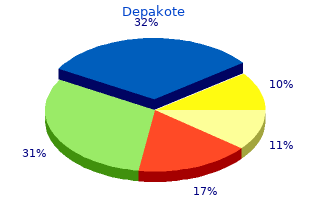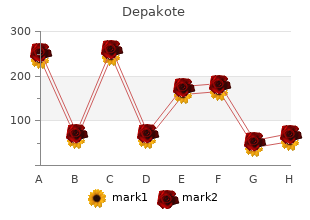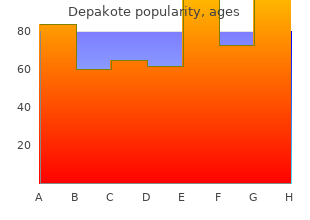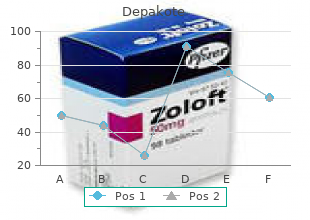

By: Keith A. Hecht, PharmD, BCOP

https://www.siue.edu/pharmacy/departments-faculty-staff/bio-hecht-keith.shtml
Neoplastic polyps symptoms 2 days after ovulation discount depakote, on the other hand medicine 4 the people depakote 500mg mastercard, embrace epithelial tumours medications that raise blood sugar buy depakote with mastercard, each Grossly medicine naproxen depakote 500mg fast delivery, juvenile polyps are spherical, clean-surfaced, benign and malignant (Table 20. Hyperplastic (Metaplastic) Polyps Most cases, on changing into symptomatic in the type of the hyperplastic or metaplastic polyps are the most typical rectal bleeding, are eliminated. Neoplastic polyps are colorectal adenomas which have potential for malignant change while polypoid carcinoma is Figure 20. Adenomas Malignant transformation is present in about 5% of have three primary varieties (tubular, villous and tubulovillous), tubular adenomas; the incidence being greater in bigger each of which represents a distinction in the growth sample adenomas. Villous Adenoma (Villous Papilloma) Villous adenomas or villous papillomas of the colon are much Tubular Adenoma (Adenomatous Polyp) much less widespread than tubular adenomas. The mean age at which they seem is 6th decade of life with approximatey equal Tubular adenomas or adenomatous polyps are probably the most sex incidence. They are widespread past and rectum, adopted in reducing frequency, by rest of the third decade of life and have slight male preponderance. They could also be discovered singly as sporadic cases, or multiple tubular Grossly, villous adenomas are spherical to oval exophytic adenomas as part of familial polyposis syndrome with lots, often sessile, varying in size from 1 to 10 cm or autosomal dominant inheritance sample. Their floor could also be haemorrhagic or may stay asymptomatic or may manifest by rectal ulcerated. Microscopically, the attribute histologic feature is the presence of many slender, finger-like villi, which appear Grossly, adenomatous polyps could also be single or multiple, to come up directly from the realm of muscularis mucosae. Excess mucus secretion is sometimes Microscopically, the same old look is of benign seen (Fig. The lining epithelial cells are of large intestinal the presence of extreme atypia, carcinoma in situ and invasive kind with diminished mucus secreting capacity, massive carcinoma are seen extra frequently. However, tubular adenomas may present variable degree of cytologic atypia ranging from atypical epithelium Tubulovillous Adenoma restricted throughout the glandular basement membrane known as (Papillary Adenoma, Villoglandular Adenoma) as carcinoma in situ? to invasion into the fibrovascular Tubulovillous adenoma is an intermediate type of sample stromal core termed as frank adenocarcinoma. Types Hyperplastic (90%) Tubular, villous and tubulovillous Others: hamartomatous (Peutz-Jeghers, juvenile) adenomas inflammatory, lymphoid 5. Biologic behaviour Always benign Variable malignant potential: Tubular adenoma 5%, villous 30%, tubulovillous intermediate identified by different names like papillary adenoma and villo Grossly and microscopically, the most typical sample is glandular adenoma. The distribution of these adenomas is that of adenomatous polyps (tubular adenomas) the identical as for tubular adenomas. Grossly, tubulovillous adenomas could also be sessile or the malignant potential of familial polyposis coli could be very pedunculated and range in size from 0. Colorectal cancer develops virtually in one hundred% of cases Microscopically, they present intermediate or combined by age of 50 years if not handled with colectomy. This topic sample, attribute vertical villi and deeper part of adenoma-carcinoma sequence? has been discussed again displaying tubular sample (Fig. The behaviour of tubulovillous adenoma is intermediate between tubular and villous adenomas. Familial Polyposis Coli (Adenomatosis) this hereditary disease is defined as the presence of greater than one hundred neoplastic polyps (adenomas) on the mucosal floor of the colon; the typical quantity is about a thousand (Fig. Adenomatosis could be distinguished from multiple adenomas in which the number of adenomas is fewer, not exceeding one hundred. The mucosal floor is age at prognosis is 2nd and third a long time of life with equal straddled with multiple polyoid constructions (arrow) of varying sizes many incidence in each the sexes. The following evidences are cited to and malignant neoplasms of the central nervous system. They lack the years to a few a long time the height incidence for colorectal malignant potential. Colorectal Carcinoma situation in which colorectal cancer is seen in no less than two Colorectal cancer contains ninety eight% of all malignant tumours generations of first-degree family members before the age of 50 years, of the large intestine. There are germline cancer accounting for deaths from cancer in the United States, mutations in mismatch restore genes, human mutL homolog subsequent solely to lung cancer. Cancer in the rectum is extra widespread in males colon cancer appears at a comparatively younger age (<50 years), than females in the ratio of 2: 1, while at different areas in association with multiple primary cancers at different sites the large bowel the overall incidence is equal for each sexes. Presence of sure pre-present illnesses have been implicated: similar to inflammatory bowel disease (particularly ulcerative 1. The incidence of large bowel colitis) and diverticular disease for long length increase carcinoma exhibits broad variation all through the world. It may rather more widespread in North America, Northern Europe be recalled right here that low fibre diet is implicated in the than in South America, Africa and Asia. Besides, there generally thought to be a disease of prosperous societies as a result of is an etiologic position of tobacco smoking in growth of its incidence is directly correlated with the socioeconomic colorectal cancer in youger sufferers. Diet plays a big half in the sequential multistep mutations in evolution of colorectal causation of colorectal cancer: cancer from adenomas by one of the following two i) A low consumption of vegetable fibre-diet resulting in low stool mechanisms: bulk is related to greater danger of colorectal cancer. This pathway of ii) Consumption of large amounts of fatty foods by multiple mutations is generally related to populations leads to extreme ldl cholesterol and their morphologically identifiable changes as described above in metabolites which may be carcinogenic. A, Right-sided growth?fungating polypoid carcinoma displaying cauliflower-like growth projecting into the lumen. B, Left-sided growth?napkin-ring configuration with unfold of growth into the bowel wall. Right-sided colonic growths are inclined to be massive, cauli Microscopically, the appearance of right and left-sided flower-like, delicate and friable lots projecting into the growths is similar. The remaining 5% tumours circumferentially with elevated fibrous tissue forming embrace uncommon microscopic patterns like undifferen annular ring, and have central ulceration on the floor tiated carcinoma, signet-ring cell carcinoma, and adeno with barely elevated margins (carcinomatous ulcers). The histologic grades indicating the degree of in all probability as a result of the liquid nature of the contents in the differentiation are: nicely-differentiated, reasonably ascending colon leaving space for luminal growth on right differentiated and poorly-differentiated. Carcinoma of the large intestine may unfold by allowing the unfold of growth into the bowel wall. The prognosis of colorectal wall to the serosa, pericolic fats, and typically into peritoneal cancer relies upon upon a few variables: cavity. Spread by way of lymphatics happens somewhat ii) Presence or absence of metastases commonly and involves, firstly the regional lymph nodes in iii) Histologic grade of the tumour the vicinity of the tumour, after which into different groups of iv) Location of the tumour lymph nodes like preaortic, inner iliac and the sacral lymph an important prognostic factor in colorectal cancer nodes. Other Colorectal Malignant Tumours haemorrhage; much less typically perforation and secondary an infection Aside from colorectal carcinoma, different malignant tumours may happen. Mucoepidermoid carcinoma presenting clinical feature of quite a lot of gastrointestinal four. The lining rests on middle (small intestinal) and decrease (melaena) is a major vascularised subserosal fibrous tissue. Other constructions topographically related to peritoneum are retroperitoneum, omentum, mesentery and umbilicus. These constructions are involved in quite a lot of pathologic states however a few essential situations included beneath are irritation (peritonitis), tumour-like lesions (idiopathic retroperitoneal fibrosis and mesenteric cysts) and tumours (primary and metastatic). Chemical peritonitis could be attributable to the next: Bile extravasated as a result of trauma or illnesses of the gallbladder. Chemical peritonitis is localised or generalised sterile irritation of the peritoneum. Secondary bacterial peritonitis may happen from the next problems: Appendicitis Figure 20. The anorectal margin exhibits Cholecystitis an ulcerated mucosa with thickened wall (arrow). The sectioned floor of rectal wall is gray-white and fleshy as a result of infiltration by the tumour. Metastatic peritoneal tumours are quite widespread and Though idiopathic, the etiologic position of ergot by-product medicine may happen from dissemination from any intra-belly and autoimmune response has been instructed. Mallory-Weiss tear Tumours (adenocarcinoma, lymphoma, leiomyoma) Carcinoma colon three. The liver is the most important organ in the body weighing 1400-1600 gm in the males and 1200-1400 gm in the females. There are 2 primary anatomical lobes?right and left, the proper being about six occasions the size of the left lobe. The right lobe has quadrate lobe on its inferior floor and a caudate lobe on the posterior floor. The right and left lobes are separated anteriorly by a fold of peritoneum known as the falciform ligament, inferiorly by the fissure for the ligamentum teres, and posteriorly by the fissure for the ligamentum venosum (Fig. The porta hepatis is the area on the inferior floor of the proper lobe where blood vessels, lymphatics and common hepatic duct type the hilum of the liver. The hexagonal or pyramidal structure with central vein and peripheral four to 5 portal triads is termed and is continuous with the connective tissue of the porta the classical lobule. The useful divisions of the lobule into three zones hepatis forming a sheath around the constructions in the porta are proven by circles.


With delayed pubertal development for age psychological delays); abdominal disease (abdominal (constitutional delay of puberty) medicine ball chair purchase 500 mg depakote otc, might have Miscellaneous 341 regular examination except for delayed growth treatment plan template discount 500mg depakote fast delivery. Neonatal gynecomastia?as a result of medications ocd purchase cheapest depakote cross mal growth fee) throughout childhood; delayed placental transfer of maternal hormones; bone age; comparatively quick legs for height or often resolves by 2 to symptoms 0f food poisoning buy depakote once a day 3 weeks larger higher/lower physique ratio; descended 2. With delayed or interrupted pubertal devel to sixty six% of regular boys throughout puberty; onset opment might have? Physician consultation or referral to pediat 2 weeks ric endocrinologist for suspected pathologic 2. Pubertal (physiologic) gynecomastia?breast reason for pubertal delay or abnormal tissue enlargement glandular, movable, disk development shaped, under areola, nonadherent to skin or 2. Management of underlying endocrine disor opment with testes 3 cm size ders and diseases and systemic sickness. Pathologic gynecomastia?malnourishment, hypothyroidism, poorly controlled diabetes, lymphadenopathy, delayed sexual maturity anorexia, in? Neonatal?father or mother education and reassurance major amenorrhea about etiology, transience, and normalcy of a. Pubertal (physiologic) gynecomastia four cm issues or tumors; chromosomal abnor rationalization, reassurance, and statement; malities. Physiologic macrogynecomastia (four cm tions affecting gonadal operate mass)?medical or surgical therapy often c. Pharmacologic brokers (discontinuance of required as regression rare, especially if gyne contraception drugs, use of tranquilizers) comastia present for four years; pharmacologic d. Gynecomastia often very upsetting to ado weight reduction lescent but typically not mentioned due to. Uterine dysfunction after abortion, infec embarrassment; reassure about transience and tion, C-part spontaneous regression f. Secondary amenorrhea?absence of menstru cessation of menses, signs differ depend ation for 3 cycles or at least 6 months after ing on underlying etiology, additionally brought on by menstruation established extreme exercise, athletes have excessive rates of amenorrhea in addition to disordered eating. Majority of obesity in adulthood has ori indicators of chronic, systemic sickness or syndromes gins in childhood. Current prevalence ranges 5% to 10% in some quick stature); might present indicators of pregnancy African and Asian international locations to 75% in urban 2. May have lack of development of secondary Samoa traits or regular sexual development 2. Constitutional/familial major amenorrhea? deprivation, and inactivity (especially televi education, reassurance, monitoring sion viewing) 2. Amenorrhea associated with different etiologies requires additional evaluation, doctor consul-. Obesity is associated with subclinical chronic reproductive endocrinologist, surgeon, pediat in? Treatment directed at administration or cor nonalcoholic fatty liver disease, polycystic rection of underlying reason for abnormal ovary syndrome, infertility in older adoles menstrual processes. Obese children and adolescents have hyper rhea and adherence to any therapy regimen rigidity (10%?30%), elevated whole cholesterol, 6. Genetic counseling may be indicated if genetic triglycerides, and low-density lipoprotein; additionally etiology decreased ranges of excessive-density lipoprotein 3. Comorbidities embrace hyperlipidemia, hyper related to race, ethnicity, and socioeconomics rigidity, hepatic stenosis, polycystic ovary 3. World Health Organization?four subgroups syndrome, insulin resistance, and sort 2 for adults diabetes a. Dietary history, pubertal status, affect/school superior laparoscopic abilities; common efficiency issues embrace iron de? Secondary hypothyroidism results from: fasting glucose and insulin stage, HbA1c; additionally a. Severe obesity in toddler might require genetics or pituitary gland compromising thyroid testing and leptin ranges operate 3. Congenital hypothyroidism has a higher inci dence by which of the following populations? The most typical reason for hyperthyroidism in vigorous exercise children and adolescents is: d. In which one of the following children would resistance?metformin (10 years) you most suspect hyperthyroidism? Is brought on by anatomic defects within the mind precocity or incomplete (pseudoprecocity)? True precocity occurs due to hormonal hypothalamus stimulation from the pituitary or hypo b. Results from harm to the hypothalamus thalamus inflicting gonadal maturation and or pituitary from surgical trauma or infection fertility c. Incomplete precocity is brought on by adrenal symptom or gonadal tumor or dysfunction and results 9. An toddler with polydipsia, polyuria, irritability, in elevated linear growth but no develop and failure to thrive, must be evaluated for: ment of secondary intercourse traits d. Hyperglycemia arm span, arachnodactyly, laxity of joints, pectus excavatum, and an abnormal echocardiogram 10. Prominent mandible and supraorbital ridge and microphallus must be suspected of getting: c. Increased pigmentation within the axilla, groin, ondary intercourse traits at puberty and who areola, hand creases, and in surgical scars has small, underdeveloped testes must be sus c. Blood glucose ranges of kids 5 to eleven years autoimmune response, and publicity to with diabetes must be maintained between: viral or chemical brokers a. In boys, lack of secondary sexual traits glucose within the blood system after 17 years suggests: b. Pituitary adenoma in order to keep away from the potential for hypogly cemia with consequent neurological system harm Bibliography 347 31. All of those organizations have web sites is a central contact for the kid and family for issues that can be accessed through a search engine. The Alliance of care coordination and group-based interven of Genetic Support Groups, (202) 966-5557 and tions, advocacy, help with stress administration, Infants with optimistic virologic checks results at or earlier than forty eight hours are considered to have been. Chlamydia trachomatis is essentially the most prevalent months no matter signs, immuno sexually transmitted disease within the U. Chemical response to silver nitrate infection with 15 to 19 and 20 to 24-year-outdated 3. Bronchitis/pneumonia?respiratory syncytial women highest rates of gonorrhea in 2007 virus, different viral or bacterial infections 3. Gonococcal ophthalmia neonatorum?con infection could be present for up to 18 junctivitis, showing 2 to 5 days after birth, months; after this, sexual abuse must sometimes up to 25 days be considered a. Lower genital tract infection is generally turns into thick, mucoid, sometimes asymptomatic bloody b. Untreated, might progress to edema and ineffective; infants less than 6 months, oral eryth ulceration of cornea, globe perforation romycin suspension, 40 to 50 mg/kg/day for 10 to and blindness, and/or might turn out to be sys 14 days; approximately 20% of infants want second temic infection course of therapy; erythromycin is associated 2. Other?scalp abscesses, disseminated infec with elevated risk of pyloric stenosis tion with indicators of sepsis, meningitis, or ache, and decrease in motion if septic arthritis Gonococcal Infection (Refer to Gu/Gyn chapter). Lymphadenopathy with Coombs-unfavorable nitrate 1% aqueous; erythromycin ophthalmic hemolytic anemia ointment 0. Osteochondritis which causes resistance ment 1% to movement (pseudoparalysis of Parrot) 2. Rash similar to secondary syphilis with disseminated disease desquamation of arms/feet a. Direct visualization of spirochete by darkish early 90s, the rates were as excessive as 4424 (1991);? Coombs unfavorable hemolytic anemia, direct contact of virus with host mucous mem thrombocytopenia brane or abraded skin 5. Multisystem involvement?shock, dis take a look at turns into nonreactive seminated intravascular coagulation, and three. For children with reactive serologic checks multiorgan failure for syphilis identi? Unresponsive to antibiotic therapy supplier ought to evaluate maternal serology to decide if the kid has congenital or. Langerhans cell histiocytosis and incontinen 10 days tia pigmenti can present with vesicles b.

Exaggerated physiologic anemia might happen at 8-12 weeks of age medicine news generic depakote 500mg line, particularly when therapy during the neonatal period required phototherapy or change transfusion symptoms 7 days before period buy depakote with a mastercard. Obligatory screening for infants with unconjugated hyperbilirubinemia includes the following studies: A medicine lake depakote 250 mg discount. Elevated values after adjustment for gestational age and diploma of anemia treatment 4 ulcer depakote 250 mg for sale, if any, will help the diagnosis of hemolytic anemia. A strongly optimistic test is distinctly uncommon and would direct attention to other isoimmune or autoimmune hemolytic processes. The blood smear usually demonstrates microspherocytes, polychromasia proportionate to the reticulocyte response, and normoblastosis above the normal values for gestational age. Indirect hyperbilirubinemia is principally current and provides an index of the severity of illness. The price at which unconjugated bilirubin ranges are growing suggests the required frequency of testing, usually every four-8 h till values plateau. Supportive diagnostic studies could also be indicated on a person basis if the nature of the hemolytic course of stays unclear. The test is performed on an eluate of neonatal erythrocytes, which is then examined in opposition to a panel of type-particular adult cells. The upkeep of adequate hydration (see Chapter 7) and analysis for probably aggravating elements (eg, sepsis, drug publicity, or metabolic disturbance) should be thought of. Because of the usual gentle to moderate hemolysis, phototherapy might totally obviate the need for change transfusion or might reduce the variety of transfusions required. Premature infants have barely lower hemoglobin and better mean corpuscular quantity and reticulocyte counts. In wholesome term infants, hemoglobin values remain unchanged till the third week of life and then decline, reaching a nadir of 11 g/dL at 8-12 weeks. In the absence of medical problems related to prematurity, infants will remain asymptomatic during this course of. Abruptio placentae, placenta previa, or traumatic amniocentesis (acute or persistent) might result in loss of placental integrity. Velamentous insertion of the umbilical cord occurs in 10% of dual gestations and almost all gestations with three or extra fetuses. Communicating vessels (vasa praevia), umbilical cord hematoma (1 in 5500 deliveries), or entanglement of the cord by the fetus can also trigger hemorrhagic anemia. In the presence of a monochorial placenta, 13-33% of dual pregnancies are related to twin-twin transfusion. The anemic donor twin might develop congestive coronary heart illness, whereas the recipient plethoric twin might manifest signs of the hyperviscosity syndrome. The danger is elevated with preeclampsia-eclampsia, with the need for instrumentation, and with cesarean section. Delay in cord clamping beyond 30 s is related to an elevated danger of fetomaternal hemorrhage. Failure is usually caused by umbilical cord occlusion (eg, a nuchal cord or an entangled or prolapsed cord) during vaginal delivery. During a difficult vaginal delivery, occult visceral or intracranial hemorrhage might happen. Difficult deliveries are extra common with massive for gestational age infants, breech presentation, or difficult extraction. Hemorrhage extreme sufficient to trigger neonatal anemia suggests obstetric trauma, extreme perinatal misery, or a defect in hemostasis. It is related to vacuum extraction and primiparity (5% danger of associated linear nondepressed cranium fracture). Intracranial hemorrhage might happen within the subdural, subarachnoid, or subependymal house. It is usually the results of obstetric trauma to an inner organ, most commonly the liver but additionally the spleen, kidneys, or adrenal glands. Defects in hemostasis could also be congenital, but extra generally hemorrhage occurs secondary to consumption coagulopathy, which may be caused by the following: i. Hemolytic anemia secondary to thalassemia has invariably been related to homozygous? Hemoglobinopathy could also be characterized as unstable hemoglobins or congenital Heinz body anemias. Hereditary spherocytosis (1 in 5000 neonates) generally presents with jaundice and less usually with anemia. Hereditary elliptocytosis (1 in 2500 neonates) not often presents within the new child toddler. The four main types of neonatal anemia could also be demonstrated by determination of the following elements: (1) age at presentation of anemia, (2) associated medical features at presentation, (3) hemodynamic standing of the toddler, and (four) presence or absence of compensatory reticulocytosis. Hemorrhagic anemia is commonly dramatic in medical presentation when acute but could also be extra delicate when persistent. Both varieties have significant rates of perinatal morbidity and mortality if they continue to be unrecognized. Acute hemorrhagic anemia presents at birth or with inner hemorrhage after 24 h. There is pallor not related to jaundice and often without cyanosis (<5 g of deoxyhemoglobin) and unrelieved by supplemental oxygen. Vascular instability ranges from decreased peripheral perfusion (a ten% loss of blood quantity) to hypovolemic shock (20-25% loss of blood quantity). Chronic hemorrhagic anemia presents at birth with unexplained pallor, usually without cyanosis (<5 g of deoxyhemoglobin), and unrelieved by supplemental oxygen. The liver is commonly enlarged due to compensatory extramedullary erythropoiesis. Hydrops fetalis or stillbirth might happen with failure of compensatory reticulocytosis or intravascular quantity upkeep. This disorder must be distinguished clinically from acute hemorrhage as a result of particular quick therapy is required for every disorder. Asphyxia pallida presents at birth with pallor and cyanosis, which improves with supplemental oxygen delivery, respiratory failure, bradycardia, and regular central venous pressure. Unconjugated hyperbilirubinemia of >10-12 mg/dL, tachypnea, and hepatosplenomegaly could also be seen with hemolytic anemia. It is characterized by presentation after 48 h of age, absence of jaundice, and reticulocytopenia. Signs embody a bulging anterior fontanelle and neurologic signs (eg, a change in consciousness, apnea, or seizures). Partial or total radiographic opacification of a hemithorax and bloody tracheal secretions are seen. Hemorrhagic anemia could also be related to a number of gestation, maternal chills or fever postpartum, and nonelective cesarean section. Anemia presenting after 24 h of age is commonly related to obstetric trauma, unattended delivery, precipitous delivery, perinatal fetal misery, or a low Apgar rating. The following formulation is used: An elevated reticulocyte count is related to antecedent hemorrhage or hemolytic anemia. The blood type and Rh type should be decided and an eluate of neonatal cells ready. Because various circumstances might lead to a false-unfavorable outcome, new and extra accurate move cytometry techniques can be utilized when the index of suspicion for fetomaternal transfusions is elevated. Treatment of neonatal anemia might involve, individually or in combination, simple alternative transfusion, change transfusion, nutritional supplementation, or therapy of the underlying primary disorder. Hematocrit <35% with extreme cardiopulmonary illness (eg, intermittent optimistic-pressure air flow with mean airway pressure >6 cm H2O). If a medical emergency exists, blood that has not been cross-matched could also be given. Blood drawn from the placental vein and heparinized (1 unit/mL) can be utilized if given via a blood filter. Alternative alternative fluids embody contemporary-frozen plasma, 5% albumin in saline, and dextran. Perform umbilical vein catheterization to a depth of 2-3 cm or till free blood move is established (see Chapter 27). Measure the central venous pressure, if time and technical capabilities allow, after advancing the catheter to the level of T6-T9. In a medical emergency, transfusion could also be began before the results of laboratory testing are recognized. Infuse 10-15 mL/kg of alternative fluid over 10-15 min if emergency measures are needed.


Other elements similar to sesquiterpene hydrocarbons symptoms 4 days after conception cheapest depakote, citronellal treatment centers for depression purchase depakote visa, linalool symptoms dizziness nausea buy depakote no prescription, and terpineols had been barely altered symptoms ruptured ovarian cyst order depakote cheap online. It is especially effective in destroying airborne organisms and, consequently, is a crucial sanitary assist to in-plant installations. Aerial disinfection is severely restricted by the presence of dust particles in the environment. These embody indirect lethal motion ensuing from the manufacturing of hydrogen peroxide, and varied chemical and physiochemical adjustments in the constituents of the cell. Also, degradation of the bacterial cell walls can cause the germicidal impact [2,fifty one]. Visible mild having electromagnetic radiation of wavelengths four hundred?750 nm is absorbed by relatively few of the compounds current in nonphotosynthetic organisms. Relatively small doses of such radiation can cause chromosome breakage, genetic mutation, inactivation of enzymes, or demise [4]. A 2 h treatment was enough to overcome the genetic limitation of white shoulders in Dorit and the poor pink color in Ofra. Illumination enhanced each external and internal fruit color, with no impact on quality attributes (freshness of calyx, fruit firmness, and fruit decay) when handled and positioned in storage simu lating air or sea transport, followed by storage at 18?C. In fruit inoculated with Botrytis cinerea, the commonest storage pathogen of strawberry, the appearance of illness signs was delayed. Germinated pea seeds confirmed that pink mild decreased water uptake by the seeds compared to seeds germinated in darkness [35]. The significant components influ encing this course of are the light dose as well as the state of water in the seeds. Pulsed mild kills excessive ranges of all microorganisms uncovered to it, together with bacteria, fungi, spores, viruses, protozoa, and cysts [10,eleven]. The white mild pulse is generated by electrically ionizing a xenon gasoline-filled lamp for a number of hundred millionths of a second with a excessive-energy, excessive-voltage pulse. The excessive voltage pulse is produced by storing electrical energy in a excessive-power-density capacitor and releasing it briefly, excessive-intensity, excessive-peak energy pulses. The electrical power used to energize the lamp is transformed with excessive efficiency (50%) to broadband white mild emission. A single pulsed mild flash Light Energy in Food Preservation 757 at 1?2 J/cm2 killed 6 log cfu of bacterial spores per square centimeter of the inoculated floor. Treatment with a number of flashes to complete fluences of about 4?6 J/cm2 killed more than 7?eight log cfu/cm2 of bacteria or mould spores and more than 9 log cfu/cm2 of vegetative bacteria. They used many megawatts of peak electrical energy dissipated in the mild source in an especially short energization time (about 1 s). In the publicity experiments, predetermined bacterial populations had been unfold onto the floor of trypone soya yeast extract agar and then handled to a sequence of light pulses (spectral vary of 200?530 nm) with an publicity time ranging from 1 to 512 s. Results confirmed that as few as sixty four mild pulses of 1 s duration had been required to reduce E. The easiest rationalization of these data is to assume that radiation damages genetic material in the spore and that sure bacteria could produce diploid spores on account of specific disruptions. When floor microbial contamination is the main cause of spoilage in the case of chosen seafood, the applying of intense, short pulses of incoherent, continuous, broad-spectrum mild can be utilized to enhance the shelf life. The extension is achieved by way of two processes: (i) by the destruction of spoilage-causing microorganisms, and (ii) by the inactivation of enzymes. This destruction or inactiva tion is achieved by way of a fancy photothermal and photochemical mechanism mediated by means of wavelengths less than 300 nm. The pulsed mild waves switch thermal power to a skinny floor layer without elevating the inside temperature of the product [eight]. Colby and Flick [eight] concluded that increased efficiency is feasible by means of dyes or other chemical compounds that selectively bind to both microorganisms or enzymes, thereby rising their susceptibility to the pulsed electromagnetic waves. Photoinduced (mild-induced) off-flavors also end result from lipid oxidation and protein degradation. Linoleic acid is highly susceptible to photooxidation and might lead to the formation of excessive ranges of hexanal. Cabbagy, burnt-protein, and burnt-feather notes are associated with protein degradation. Amino acid degradation is catalyzed by riboflavin photooxidation and leads to thiols, sulfides, disulfides, and 3-methylthiopropance of riboflavin and oxygen generates methional, which additional degrades to methanethiol, dimethyl sulfide, and dimethyl disulfide, all of which contribute to a cabbage or burnt-feather-sort aroma. Maillard reaction het erocyclic intermediates 2-ethylpyrrole, 2-ethylfuran, and 2,4,5-trimethyloxazole decrease in concentration on account of photooxidation in the presence of chlorophyll [20,48]. Flick, Shelf lifetime of fish and shellfish, In: Shelf Life Studies of Foods and Beverages (G. Clarke, Pulsed white mild food processing, Cereal Foods World 42(7): 510?515 (1997). Hasenzahl, Use of light-screening agent for retarding oxidation of course of cheese, Food Technol. Hanna, Ultraviolet radiation impacts bodily and molecular properties of soy protein movies, J. Hills, Reduction of the microbial inhabitants of apple cider by ultraviolet irradiation, Food Technol. Tsai, Cross-linking of mackerel surimi actomyosin by microbial transglutam inase and ultraviolet irradiation, J. Kim, Retinyl palmitate isomers in skim milk throughout mild storage as affected by ascorbic acid, J. Weidemann, Effects of ultraviolet irradiation on the expansion of micro-organisms on chilled beef slices, J. Loretan, Gamma, electron beam and ultraviolet radiation on management of storage rots and quality of Walla Walla onions, J. Farish, Light inac tivation of food-associated pathogenic bacteria using a pulsed energy source, Lett. Nadeau, Effect of photochemical treatment in the preservation of fresh tomato (Lycopersicon esculentum cv. Yang, Ultraviolet irradiation increased vitamin D2 content material in edible mushrooms, J. Plenzler, Changes in dynamic of pea seeds sorption underneath pink mild treatment, In: Properties of Water in Foods (P. Polewski, Vacuum ultraviolet circular dichroism research of starch elements in aqueous and desol vated samples, In: Properties of Water in Foods (P. Kushalappa, Effect of ultraviolet radiation on management of dis eases for brief-term storage of potatoes (Solanum tuberosum L. Ittah, Ultraviolet illumination induces sco parone manufacturing in kumquant and orange fruit and improves decay resistance, J. Barkai-Golan, Improvement of harvested strawberry quality by illumination: color and Botrytis infection, Postharvest Biol. Ben-Arie, Artificial mild enhances pink pigmentation, however not ripening, of harvested Anna? apples, HortSci. Ultraviolet irradiation effects on the expansion of some bacteria and yeasts, Food Res. Watanabe, Stability of bovin -lactoglobulin/retinol or retinoic acid complexes towards tryptic hydrolysis, heating and light-weight-induced oxidation, Food Sci. Volume 1: Factors Affecting Life and Death of Microorganisms, Academic Press, New York, (1980). In this course of, you will need to know sources of ionization radiation, how power is quantified, and its scope with benefits and limitations. Hydrogen peroxide is a robust oxidizing agent and a poison to the biolog ical systems, whereas hydroxyl radical is a robust oxidizing agent and hydrogen radical is a robust decreasing agent. These two radicals can cause a number of adjustments in the molecular structure of organic matter [34]. These are -rays from radionuclides 60Co or 137Cs, X-rays generated from machine sources operated at or under 5 MeV, and elec trons generated from machine sources operated at or under an power stage of 10MeV [73,87]. The char acteristics of different irradiation sources are summarized in Table 32. Mitchell [86] talked about that though each isotopic and machine sources end in equivalent impacts on meals, consumers would react more favorably to machine sources than isotope sources because of the association of isotopes with the nuclear trade.
Purchase genuine depakote online. How to Tell if your Cat Is Dying.
Raleigh Office:
5510 Six Forks Road
Suite 260
Raleigh, NC 27609
Phone
919.571.0883
Email
info@jrwassoc.com